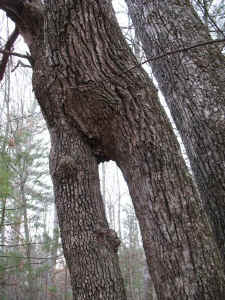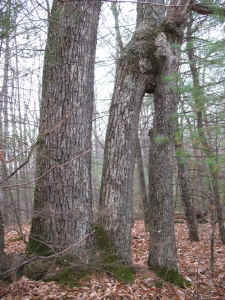|
==============================================================================
TOPIC: # 70
http://groups.google.com/group/entstrees/browse_thread/thread/65c675b73b5952e3?hl=en
==============================================================================
== 1 of 8 ==
Date: Thurs, Dec 13 2007 9:32 am
From: "Will Blozan"
ENTS,
Yesterday I went into Cataloochee to obtain some measurements of one
of the
Tsuga Search trees and explore two small coves on Winding Stair
Branch that
I had never seen before. I suspected the coves may harbor some tall
hemlocks
and they had not yet been searched. Growing in the vicinity were
several
superlative hemlocks; the Tsali (169.8' tall), Yonaguska (168.9'
tall), and
another one over 160'. I was accompanied by a writer from the local
independent newspaper here in Asheville who was doing a story on the
Tsuga
Search and the hemlock crisis. He came along to see what the forests
were
like and visit some of the superlative trees Jess and I have
documented.
After some measurements of the Yonaguska Hemlock and adjacent trees
we
headed south up a small tributary leading up to Half Acre Ridge.
This cove
contained very nice, ancient and gnarly hemlocks but none over about
145'
tall. An exceptionally nice collection of large, tall tuliptree
dominated
the richer, upper reaches of the tributary with heights to at least
160.8
feet. It was one of the finest collections I have seen (Gary may
want to see
it), with perhaps 2 acres of nearly pure, old tuliptrees 10-14'+ in
girth.
Hemlocks were trying to keep up but did not exceed 145' here either.
We went
up to the ridge to access another small cove that led back down to
the west
prong of Winding Stair Branch. On the ridge we found a nice 2.2' cbh
X 60'
American chestnut with lots of burrs but no seeds to be found.
Really
strange though was a fusion of a chestnut oak and a white oak. These
adjacent trees were not just rubbing and callused but actually fused
together. The top of the white oak (smaller stem in the photos) was
dead but
the grafted section was alive. Has anyone ever seen this before?
 |
 |
The small cove had large northern red oak and tuliptree, with
ancient
hemlock by the water. The stream was small but fairly rich and rocky
with a
thick moss and fern layer. It was very cathedral-like and tuliptrees
were
over 150'. One hemlock stood out among the others and I roughed the
height
to the mid 150's without knowing were the base was. We zeroed the
base and
set up a target. The height was 160.5 feet making this tree the 70th
eastern
hemlock documented over 160' tall. As you can see from the photo, it
was not
a small tree. Even though one bifurcation has broken off it still
will be
solidly over 1000 cubic feet, perhaps 1100. A nearby snag with a
broken top
may have been close to 160' as well.
But, like all the other hemlocks we saw, it had but a fraction of
heavily
infested foliage left and will probably die within a year. All
understory
hemlocks with new growth were slammed with maturing HWA.
Will
== 2 of 8 ==
Date: Thurs, Dec 13 2007 10:16 am
From: James Parton
Will,
I have often wondered if two trees of different species can grow
( Fuse ) together & survive. In this case you have proven that
two
different types of oak can. How about two trees of an entirely
different species? Like Maple & Oak or one of closer relation,
like
Beech & Oak? That was a really nice chestnut also. Still no
viable
nuts though..dang-it! Did you photograph it?
As usual you have done another excellent post on an excellent
outing!
Have you heard anything else on that Pre-Blight American Chestnut
you
told me about? That find is an exceptional one. Also, I am anxious
to
see a posting from the Kellogg outing we went on. Those numbers will
tell me much about the forest. It's not Cataloochee, but I was
impressed!
James Parton
== 3 of 8 ==
Date: Thurs, Dec 13 2007 10:25 am
From: "Lee E. Frelich"
Will:
I have seen several instances where two white oaks fused like that
in WI
and MN. I remember when I was a child that people in rural WI called
these
occurrences of fused white oaks 'kissing trees'. I have not seen the
phenomenon with two different species of oak.
Lee
Really strange though was a fusion of a chestnut oak and a white
oak. These
adjacent trees were not just rubbing and callused but actually fused
together. The top of the white oak (smaller stem in the photos) was
dead
but the grafted section was alive. Has anyone ever seen this before?
== 4 of 8 ==
Date: Thurs, Dec 13 2007 1:07 pm
From: Beth Koebel
Will,
I have seen this before just down the street from me.
In the case here it is of two unrelated trees. One is
a black walnut and I can't recall the other one.
Beth
== 8 of 8 ==
Date: Thurs, Dec 13 2007 8:13 pm
From: "Steve Galehouse"
James, Will, ENTS
In horticulture there are a number of examples of different species,
sometimes even separate genera, "fusing", or being grafted
together,
albeit often with human intent. Certainly as I know it any
lepidobalanus oak can grafted or interbreed with any other, an can
any
erythrobalanus oak with another, but the two groups are mutually
exclusive as far as grafts and hybridization. Same with
"soft"(5-needle) and "pitch"(2 or 3 needle)pines.
But you can graft a Cotoneaster on a Crataegus, or a Syringa on a
Ligustrum, or create a graft chimera by combining Laburnum with
Cytisus. And Sorbus and Aronia can hybridize, as well as Kalmia and
Rhododendron.
How can two genera interbreed, while species of different series
within a genus are incompatible?
It seems to me the taxonomic cladistics are awry.
Steve
== 2 of 10 ==
Date: Fri, Dec 14 2007 6:06 am
From: "Will Blozan"
Steve,
I agree with your taxonomic thoughts...
Let's not forget our favorite grafted gift to instant landscapes-
the
"Leyland Cypress". This is apparently a bi-generic hybrid
(?) that to any
arborist is simply an evergreen version of a "Bradford
Pear".
Will
== 3 of 10 ==
Date: Fri, Dec 14 2007 6:19 am
From: "William Morse"
James - I have a picture somewhere of a sugar maple and an American
beech
fused together i found in Senceca County, NY. I'll see if i can find
it on
my hard drive to pass along. I've seen other species naturally
grafted
together also (white ash/sugar maple, shadblow/American beech),
frequently
along old fence lines. very interesting picture of the oaks. I have
never
seen grafts between or within the two major divisions of the plant
kingdom
(no gymnosperms). Best regards,
Travis Morse
== 4 of 10 ==
Date: Fri, Dec 14 2007 6:32 am
From: "Will Blozan"
I too, have seen many trees fused of different species. I have seen
rocks,
metal pipes, motorcycles, and lawnmowers "fuse" to trees.
What I am
referring to is a graft, where the tissues grow together and
function
normally.
There is a white pine in TN I have seen that has encompassed a
sycamore limb
"through" a fork. The pine has completely grown around the
limb, which is
still alive and attached to the "parent" tree. The limb is
larger were it
exits the pine trunk indicating the pine may be restricting the flow
of
sugars back to the parent tree.
Will
== 5 of 10 ==
Date: Fri, Dec 14 2007 6:34 am
From: "William Morse"
Hi Will, up until recently the Nootka Cypress was of the same genera
as the
Monterey Cypress (*Cupressus*). (Leyland Cypress is Nootka x
Monterey). It
was only in the last few years (2003-4?) that Nootka was
reclassified
as *Callitropsis.
*Still, the biggest argument I have heard against the recent
placement of
the Nootka Cypress is the ready formation of the hybrid with the
Monterey
Cypress. It seems like your question-mark is well placed..... Travis
== 6 of 10 ==
Date: Fri, Dec 14 2007 7:27 am
From: James Parton
Will,
I did not know that. What is the Leyland Cypress hybidized from?
James Parton
== 7 of 10 ==
Date: Fri, Dec 14 2007 7:29 am
From: doug bidlack
Hi guys,
I'm not so sure I agree with the idea that two plants
that interbreed must be in the same genus. After all,
if you take this one step further, you basically have
the biological species concept. I don't believe that
you must consider two organisms to be of the same
species if those two species can interbreed and
produce viable offspring. If I did, I would have to
consider White Oak, Swamp White Oak, Bur Oak, Chestnut
Oak and all the other 'white oaks' to be one species.
In the same vein, just because we can force two
different organisms in different genera to interbreed,
I don't think that we can say that they must be in the
same genus on this basis alone.
Doug
== 8 of 10 ==
Date: Fri, Dec 14 2007 7:32 am
From: James Parton
Will,
This reminds me of Strangler Figs in the tropics. They start life as
a
seed high in the canopy and grow downward to the ground, gradually
enveloping the whole " host " tree & killing it. In
the end only the
fig remains, taking the hosts place.
James Parton.
== 9 of 10 ==
Date: Fri, Dec 14 2007 7:34 am
From: James Parton
William,
You answered the question I asked Will. I have read of Monterrey
Cypress but have never heard of Nootka.
James P.
== 10 of 10 ==
Date: Fri, Dec 14 2007 7:50 am
From: "William Morse"
Hi Doug,
Some genera have been found to be definitely incompatible, but many
others
are cross fertile. There certainly are bi-generic hybrids. There are
even
three and four genera crosses! It is true that genera do not
intermingle
readily, so the generic lines remain generally pure. Species, on the
otherhand, usually intermingle readily.
Travis
==============================================================================
TOPIC: # 70
http://groups.google.com/group/entstrees/browse_thread/thread/65c675b73b5952e3?hl=en
==============================================================================
== 1 of 1 ==
Date: Fri, Dec 14 2007 2:10 pm
From: "Steve Galehouse"
Travis, Doug-
Traditionally Nootka Cypress (Alaska Cedar) has been considered a
false-cypress, *Chamaecyparis nootkatensis*, and Leyland as a
bi-generic
cross between it and* Cupressus macrocarpa; X Cupressocyparis
leylandii*.
Nootka has now been placed in its own genus, *Callitopsis*, but the
cross
forming Leyland is still considered bi-generic, and Leyland Cypress
nomenclature hasn't changed yet.
But the quandary for me is some genera contain series of species
that are
fully incompatible--a white oak type doesn't, and can't be forced to
cross
with any of the red oak types, just as none of the milky-sapped
maples are
able to cross with a clear-sap species(you can't cross a Norway with
a Sugar
maple). Perhaps ability to hybridize, or lack of, doesn't
necessarily
reflect genetic relationship, but intuitively it would seem that two
species
which can form a hybrid are more closely related to one-another than
two
which can't, whether or not in the same genus. But this would then
mean our
system of taxonomic nomenclature doesn't reflect the real
relationships of
the plants.
Steve
==============================================================================
TOPIC: # 70
http://groups.google.com/group/entstrees/browse_thread/thread/65c675b73b5952e3?hl=en
==============================================================================
== 1 of 1 ==
Date: Mon, Dec 17 2007 2:45 pm
From: "Brandon Gallagher"
In the world of multigeneric hybridization the orchid growers have
many
bi-,tri-, and quadgeneric hybrids. For instance the
"artificial" genus
Burrageara is a cross between the four genera Miltonia, Oncidium,
Odontoglossum, Cochlioda. I think it is important to always remember
taxonomy is vastly more simplistic system than perhaps really exists
in
nature. It works great for small groups but if you start delving too
deep it falls apart. Venture a little into the 25,000 named species
in
the Orchidaceae family and it the problems with
Family>Genus>Species
become mind-boggling!
Brandon Gallagher Watson
|